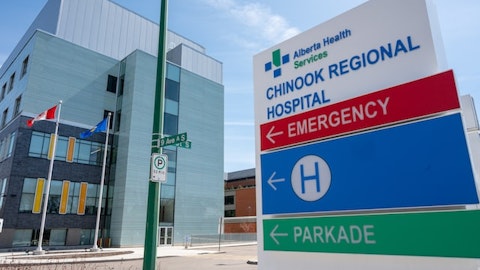Sage Therapeutics, Inc. (NASDAQ:SAGE) Q3 2023 Earnings Call Transcript November 7, 2023
Operator: Good morning. Welcome to Sage Therapeutics’ Third Quarter 2023 Conference Call. [Operator Instructions]. This call is being webcast live on the Investors and Media section of Sages’ website at sagerx.com. This call is the property of Sage Therapeutics and recording, reproduction or transmission of this call without the express written consent of Sage Therapeutics is strictly prohibited. Please note this call is being recorded. I would now like to introduce Ashley Kaplowitz, Director of Investor Relations at Sage.
Ashley Kaplowitz: Good morning and thank you for joining Sage Therapeutics’ third quarter 2023 financial results conference call. Before we begin, I encourage everyone to go to the Investors and Media section of our website at sagerx.com where you can find the press release related to today’s call as well as slides that we will be reviewing today. I would like to point out that we will be making forward-looking statements which are based on our current expectations and beliefs. These statements are subject to certain risks and uncertainties and our actual results may differ materially. Please review the risk factors discussed in today’s press release and our SEC filings for additional details. We will begin the call with prepared remarks by Barry Greene, our Chief Executive Officer, who will provide an overview of our progress during the third quarter of 2023.
Our Chief Business Officer Chris Benecchi will provide an update on our preparations for the planned commercial availability and launch of ZURZUVAE. We will also be joined by Laura Gault, our Chief Medical Officer, who will review recent progress across our pipeline, and by Kimi Iguchi, our Chief Financial Officer who will review the financial results from the third quarter of 2023. Mike Quirk, our Chief Scientific Officer will be available for questions during the Q&A portion of the call. With that I’ll now turn the call over to Barry.
Barry Greene: Thanks, Ashley, and thank you, everyone, for joining us this morning. We at Sage have a purpose and the momentum that unite to solve. The recent approval of ZURZUVAE as a treatment for adults with postpartum depression sparked a national dialogue with countless women sharing their stories online, building community and expressing anticipation for a desperately needed new treatment option. These brave and inspiring women are a north star and making a meaningful impact to women’s health by focusing on the material mental health crisis brought about by PPD is our ambition. The approval of ZURZUVAE further validates our innovative approach to drug discovery and development, which starts with our work targeting the GABA and NMDA receptor systems in the brain.
These pathways are key regulators of brain function and the main drivers of brain circuit activity. Research suggests that disruptions in these circuits are an underlying factor in many brain health disorders. Our deep understanding of these pathways, along with our robust neuroactive steroid platform are vital to unlock potential therapeutic breakthroughs for patients. We are not satisfied with the speed of innovation for brain health treatments. Brain health disorders are one of the leading causes of disability worldwide because the pace of innovation has not met the moment. To address this innovation gap, we’re advancing our pipeline with the goal of elevating the standard of care to what truly matters most to patients. We’re working to help people living with debilitating neurodegenerative disorders who have been seeking treatments to address cognitive impairment early in order to maintain their independence longer and we strive to be the first company to deliver a new treatment for essential tremor in over 50 years.
Patients are waiting and I’m proud to lead Sage forward. This starts with postpartum depression or PPD. As the first and only oral treatment approved for adults with PPD, ZURZUVAE has the potential to transform the treatment landscape as a new option in care. Women with PPD need new solutions to the devastating disorder that have the potential to [indiscernible] and we are now one step closer to helping these patients and their families. Untreated PPD is a burden and can have lasting consequences for the mom and is also associated with negative outcomes for her baby and the entire family. Additionally, undertreated and untreated PPD has significant societal cost. We are pleased that the DEA completed its scheduling of ZURZUVAE as a Schedule IV drug, which is consistent with our expectations.
We remain on track to make ZURZUVAE commercially available in December of this year. Now Chris will provide specific updates related to this time line. The heightened and persistent engagement we’ve seen from a diverse community of stakeholders since the FDA approval of ZURZUVAE in August, we believe will ultimately translate into strong tailwinds for the launch success of ZURZUVAE. While we recognize that referral patterns, insurance coverage and current practices require change, we believe those women suffering from PPD deserve our full support effort starting now. PPD is a serious medical condition and deserves attention. We plan to join others in prioritizing, normalizing and destigmatizing this condition. While we remain focused on preparing for the launch of ZURZUVAE, we’re also excited about entering what we believe will be a catalyst-rich 2024, with multiple data readouts expected across our SAGE-718 and SAGE-324 programs.
Today, Laura will provide updates and more details on these programs. Looking ahead, we believe our future is bright. Following the reduction in our workforce and pipeline prioritization announced in late August of this year, we continue to operate from a strong financial foundation. Importantly, we remain well capitalized to accomplish our upcoming milestone. Kimi will provide more detail on our financial position later in the call. Now many continue to ask about the status of development of zuranolone and MDD. To be clear, our focus is on the successful launch of ZURZUVAE for women with PPD and working to enable broad and equitable access to these patients to important new treatment options. On MDD, we plan to provide updates when Sage and Biogen have made decisions on the program.
For now we’re focused on commercializing ZURZUVAE for the treatment of adults with PPD. To close, I want to reiterate that this is an exciting time to Sage with many upcoming milestones on the horizon. As we look ahead, I’m confident we’re positioned to make important progress in pursuit of our mission. With that, I’ll turn the call over to Chris to provide additional context on our upcoming commercialization plans for ZURZUVAE. Chris?
Christopher Benecchi: Thanks, Barry. I’m pleased to be with all of you this morning to share updates on our preparations for the commercialization of ZURZUVAE as a treatment for women with PPD. Since the FDA approval in August, we’ve been working closely with our collaboration partner Biogen on the commercialization strategy for ZURZUVAE. Urgency is top of mind given the significant unmet need that currently exists in PPD. In the U.S., it is estimated that approximately 1 in 8 women who have a live birth experienced symptoms of PPD each year, representing around 0.5 million women. Only half of those cases are diagnosed and even fewer are treated, leaving a substantial number of women experiencing harmful symptoms of this disease.
These statistics highlight the tremendous unmet need and compel us to act with urgency to bring forth ZURZUVAE, the first and only oral treatment specifically approved for women with PPD. We believe ZURZUVAE has the potential to be a first-line therapy and quickly become the standard of care for the many women with this disease. Following the approval of ZURZUVAE by the FDA in August and the recent DEA scheduling, we and Biogen remain committed to making ZURZUVAE commercially available in December. Making this treatment commercially available as soon as possible is our top priority. We know that weeks, days and even hours matter in the lives of women with PPD and their families who struggle to live their daily lives. The broader complement of our commercialization capabilities are expected to roll out in early 2024, including planned promotional activities delivered through omnichannel efforts.
To support the commercial availability of ZURZUVAE, we and Biogen have continued to progress our commercialization preparations. I would like to detail a few specific developments essential to understanding our approach to launch. First, we are pleased to announce the completion of the hiring of the Sage field sales teams. Our field sales team of neuropsychiatry account managers are seasoned sales professionals with deep experience launching treatments essential to improving brain health conditions. They come to Sage with strong track records of success promoting innovative products and bringing established relationships within the neuropsychiatry community, enabling them to rapidly and effectively engage with high-prescribing psychiatrists, OB/GYNs and PCPs who treat women with PPD.
We will aim to amplify their selling efforts with a dynamic digital platform that provides HCP level insights designed to enable timely, improved and personalized experiences for customers. This includes tools and AI models to help communicate with HCPs at the right time with the right content. Second, we are inspired by the consistent feedback we’ve received from HCPs that ZURZUVAE has the potential to be a breakthrough treatment for women with PPD. Achieving such status is predicated on our ability to reach the broader HCP community who treat women with PPD with our promotional efforts. Quite simply, we’ll need to do more than just deploy a highly experienced focused sales force. We also plan to execute targeted digital communications as part of a larger omnichannel effort to reach the broader audience of HCPs with PPD disease state education, product information and access to tools and resources so that women with PPD can find the care that they need.
Third, our discussions with payers remain highly productive. We are actively engaged with national, regional and government payers, communicating unmet need in PPD, reinforcing the weight of the evidence observed in our PPD studies, discussing the economic burden associated with untreated PPD and engaging in dialogue about access and reimbursement for women with PPD. To be a truly breakthrough therapy in PPD, we recognize that ZURZUVAE must be both accessible and affordable and we found most payers to be aligned with its potential to be a first-line therapy for women with this disorder. Historically, health plans and PBMs conduct formal formulary reviews once the product’s label is final. As we’ve just received DEA scheduling, which now completes the ZURZUVAE label, we now anticipate formulary reviews to begin and to continue over the course of 2024.
Considering the totality of evidence from our ongoing interactions, we believe our stakeholders are increasingly recognizing that ZURZUVAE has the potential to fill an important patient need as the first and only oral once-daily 14-day treatment that can provide rapid improvements in depressive symptoms for women with PPD. I’d like to now go into more detail on our planned access strategy for ZURZUVAE, an approach to establishing the wholesale acquisition cost. Resolving PPD symptoms early is not only what’s best for mom and baby, but can also begin to address the significantly higher health care resource utilization costs associated with PPD. For example, according to a 2017 model, the multiyear average societal cost of untreated perinatal mood and anxiety disorders for mother-child pair was approximately $32,000.
Women with PPD experienced more hospital admissions and overall higher health care resource utilization and health care expenditures than women who did not have PPD. Additionally, untreated PPD can have a generational impact. Perinatal mood and anxiety disorders can be associated with delayed or impaired long-term developmental, psychological, cognitive and physical outcomes in children. In societal costs for these outcomes in one study were estimated at nearly $2 billion for all impacted children through their first 5 years of life. Broad and affordable access for women with PPD who are prescribed ZURZUVAE has been and will continue to be a critical goal for Sage and Biogen. Over the last few years, Sage and Biogen have done significant stakeholder research and directly engage payers to understand critical access considerations and the perception of value that ZURZUVAE can deliver in PPD.

We have also been engaging with advocates and HCPs to gain their insights in these important areas. Access for women with PPD, clinical value, the existing unmet need, cost effectiveness and innovation have all been key considerations for the wholesale acquisition cost of ZURZUVAE. With all of this in mind, we have set the planned wholesale acquisition cost of ZURZUVAE at $15,900. We believe the wholesale acquisition cost accurately reflects the innovation, clinical value and impact ZURZUVAE can have for women with PPD. What we’ve heard from payers in our market research in one-on-one meetings is that ZURZUVAE remains a significant advancement for the treatment of PPD and has the potential to be a first-line therapy. ZURZUVAE is within the annual wholesale acquisition cost range of other commonly prescribed branded medications used to treat brain health disorders and the wholesale acquisition cost or ZURZUVAE is within the value range for the impact it can deliver.
Sage and Biogen are working diligently with the goal of enabling all women with PPD prescribe ZURZUVAE after commercial availability, be able to access it rapidly and affordably. That is ultimately achieved by working closely with payers with the intent to drive formulary acceptance with coverage that does not require onerous utilization management tactics like prior authorizations that are complex and step edits. To this end, we and Biogen are actively engaged with national, regional and government payers. Further, both Sage and Biogen are committed to the goal of delivering broad patient access immediately at launch for women with PPD and where possible, with little to no co-pay regardless of financial means. We believe lack of financial means should not prevent any women with PPD from obtaining access to ZURZUVAE.
Beyond these updates today, we and Biogen expect to share more details related to our patient support programs, distribution strategy and overall commercialization plans at the appropriate time. With that, I will turn it over to Laura for a more detailed discussion of our recent portfolio progress and current expectations. Laura?
Laura Gault: Thanks, Chris, and good morning, everyone. Over the third quarter, we have made important progress on our pipeline programs and I’m pleased to detail our recent advancements and our plans for continued execution over the coming quarters. I’d like to start by sharing my excitement around the FDA’s approval of ZURZUVAE and the treatment of adults with PPD. This approval reinforces Sage’s commitment to supporting mothers as our first FDA-approved medicine, PURVIEW was also approved in PPD bringing the first oral 14-day treatment to the market will be immensely impactful and marks a watershed moment for brain health. Women with the disease will finally have the option of a novel oral therapy specifically indicated for PPD that has the potential to rapidly improve symptoms and enable these women to fully engage with their baby and their families during this important time in their lives.
For a full description of the risk benefit for ZURZUVAE in the treatment of PPD in adults, including important safety information, I encourage you to read the product insert. We are also encouraged to see strong enthusiasm from the medical and scientific community for ZURZUVAE and we look forward to continuing to understand new insights from clinicians as they have directly observed in their practices the benefit of ZURZUVAE in women with PPD. Turning to our neuropsychiatry pipeline. We continue to advance SAGE-718, our wholly owned first-in-class NMDA receptor-positive allosteric modulator. This is a potential oral therapy for cognitive disorders associated with NMDA receptor dysfunction, including Huntington’s disease, Parkinson’s disease and Alzheimer’s disease.
These disorders continue to grow in prevalence globally and represent some of the greatest areas of unmet need in medicine. The burden of cognitive impairment among people with these disorders is high and for many occurs during their prime working years. As a consequence, employment changes resulting from cognitive impairment and associated functional decline can affect financial independence. Our goal is to reshape the treatment of patients with cognitive impairment, starting with our SAGE-718 program. I’d like to take the opportunity to highlight our clinical development strategy for SAGE-718, where we are currently enrolling in 5 clinical trials with data readouts expected next year. Starting with Huntington’s disease, or HD, I was pleased to see the FDA grant orphan drug designation for SAGE-718 in the treatment of HD last month.
Orphan drug designation is an encouraging regulatory milestone in our HD development program and it further advances our strategy to prioritize HD as a lead indication for SAGE-718. We are currently enrolling in 3 studies. The DIMENSION study is a placebo-controlled Phase III study that will evaluate the efficacy and safety of SAGE-718 compared to placebo in patients with HD with the HD cab as the primary endpoint. The SURVEYOR study is designed to advance our understanding of the effects of SAGE-718 on cognition and functioning in participants with HD. It is designed to complement the DIMENSION study by generating evidence to better define the clinically meaningful change and the relationship between changes in cognition and function. Importantly, the DIMENSION study is powered to evaluate the SAGE-718 placebo difference in changes in cognition and function while the SURVEYOR study will explore the relationship between changes in cognition and function and is not designed or powered to show statistically significant differences between groups.
Finally, the PURVIEW study is an open-label Phase III safety study in people with cognitive impairment due to HD designed to evaluate the long-term safety profile of SAGE-718. For our Parkinson’s disease indications for SAGE-718, we are enrolled in the PRECEDENT study, a placebo-controlled Phase II study in people with cognitive impairment due to Parkinson’s disease. We are also conducting the LIGHTWAVE study, a placebo-controlled Phase III study of SAGE-718 in people with mild cognitive impairment or mild dementia due to Alzheimer’s disease. Recruitment for these studies remains on track and we look forward to sharing more detail on the timing of data readouts in the coming quarters. Now I’ll turn to SAGE-324, an investigational next-generation positive allosteric modulator of GABAA receptors.
We believe SAGE-324 holds significant potential in the treatment of movement disorders like essential tremor or ET. ET is a disease that has limited treatment options and high unmet need as there has been no innovation in the space for over 50 years. When you look into patients living with ET, you realize that that the tremor can affect nearly every aspect of their daily lives and can make the simplest task difficult, if not impossible. Currently, patients with ET often cycle through many ET treatments and have roughly twofold of the health care spending of similar patients without ET. We and our collaboration partner, Biogen, recognize the high unmet need in this space and we remain on track to complete enrollment in the ongoing Phase IIb KINETIC2 dose-ranging study for SAGE-324 this year.
As a reminder, the purpose of the KINETIC2 study is to define the dose and the associated safety tolerability profile for SAGE-324 for use as iconic treatment. We look forward to providing updates on this program, including the top line data readout of the KINETIC2 study expected in mid-2024. Lastly, we remain excited on the potential of our earlier Sage programs, including SAGE-421, SAGE-319 and SAGE-689. And we are looking carefully at early data to determine potential signals or area of opportunity for the future. With that said, our near-term focus remains on bringing forward SAGE-718 and SAGE-324. In closing, I am proud of our pipeline efforts this year and I look forward to our future progress as we prepare to enter what we believe will be a catalyst-rich 2024.
Now I’ll turn the call over for a review of our financials. Kimi?
Kimi Iguchi: Thanks, Laura. Our financial results for the third quarter of 2023 are detailed in our press release issued this morning. I’d like to take a moment to provide some context and highlight a few key points. Before discussing specifics with respect to the third quarter financials, I want to reiterate my gratitude to the entire Sage team for their resilience and continued dedication to our mission to support brain health patients in the face of difficult circumstances. Following our strategic reorganization announced in August 2023, we maintain our strong financial foundation and continue to pursue focused execution across our pipeline. As a reminder, we believe the financial impact of the reorganization will result in annualized savings of approximately $240 million, which includes $100 million related to the workforce reduction.
Looking ahead, we’re prepared to execute on key milestones with the planned launch of ZURZUVAE and multiple expected top line data readouts for SAGE-718 and SAGE-324. In the near term, we’re laser focused on the commercialization of ZURZUVAE in the treatment of adults with PPD. As a reminder, we and Biogen are jointly supporting the planned launch of ZURZUVAE with a 50-50 cost sharing in the United States. While we’re thinking big about the launch opportunity in this indication, we intend to start with a focused approach and scale fast as we see success. Once launched, we expect to provide updates on ZURZUVAE during our quarterly earnings call, including metrics such as revenue and prescription data. In addition, we remain committed to making smart, disciplined investments across our pipeline.
While our current focus remains on SAGE-217 and SAGE-324, we successfully built a strategic reservoir of molecules, ranging from research through clinical Phase II ready that we believe provides optionality and agility in our portfolio. With a variety of programs across GABA, NMDA and new exciting targets, we will continue to make portfolio decisions informed by opportunities, timing and outcomes of our late-stage portfolio and exploratory investments. Turning to our financial results for the third quarter. Our net loss for the third quarter of 2023 was $202 million. As a reminder, we ended the third quarter with cash, cash equivalents and marketable securities of approximately $876 million. Turning to operating expenses. R&D expenses were $102 million in the third quarter of 2023.
The increase compared to the third quarter of last year was primarily due to expenses relating to canceling excess purchase commitments from manufacturing as a result of the CRL received from FDA for zuranolone for the treatment of MDD. SG&A expenses were $78 million in the third quarter of 2023. The increase compared to the third quarter of last year was primarily due to stock-based compensation expense related to performance-based vesting criteria during the third quarter of 2023. We’re also reaffirming that based on our current estimates, we anticipate current cash, cash equivalents and marketable securities, along with anticipated funding from ongoing collaborations, collaboration revenue from sales of ZURZUVAE and a potential milestone payment totaling $75 million from Biogen related to the first commercial sale of ZURZUVAE for the treatment of PPD will all support operations into 2026.
As we near major expected clinical catalyst, I’m confident that our balance sheet with expected runway into 2026 will enable focused execution toward our mission. We look forward to 2024 as we believe will make a difference in the lives of brain health patients by accelerating our progress to bring medicines that matter to market. I’ll now turn it over to Ashley to handle Q&A with the operator. Ashley?
Ashley Kaplowitz: Thanks, Kimi. Before I turn it over to the operator, I’ll ask that you limit yourself to one question. If you have an additional question, feel free to return to the queue. Now I’ll turn it over to the operator to handle Q&A. Operator?
See also 12 Most Powerful Countries in the Middle East Heading into 2024 and 21 Best Places to Retire in Canada.
Q&A Session
Follow Sage Therapeutics Inc. (NASDAQ:SAGE)
Follow Sage Therapeutics Inc. (NASDAQ:SAGE)
Operator: [Operator Instructions]. And we go to our first question from Ritu Baral with TD Cowen.
Ritu Baral: I wanted to ask for a little more detail on your HCP targeting effort. I guess you mentioned OB/GYNs, neuropsychs and I guess, HCP to see a large volume of PPD patients from other specialties, I’m assuming. How are you going to sort of balance proportionally the targeting effort between those 3 groups? And insofar as you talk about HCP that see a large volume of PPD, are you talking about primary care, nurse practitioners, sort of how should we be thinking about that group?
Barry Greene: Thanks, Ritu. I’ll start and then ask Chris to dive into some more details. So you’ve got it right. As we said in our prepared remarks, we believe that the majority of women suffering from postpartum depression will be seen by their OB/GYNs, psych and PCP in terms of treating their postpartum. One of the big changes we see occurring in the market with PPD is that OB/GYN, since it’s in our guidelines and they now have really the solution that they haven’t had before, is a big — a big uptick in OB/GYN screening, diagnosing and treating these moms. So those are the 3 groups. Now we talk about OB/GYN, psych or primary care. We’re talking about the offices. So the health care providers in general, physicians, physicians’ assistants and nurse practitioners.
And those 2 latter groups, we actually see as a big part of the treatment pattern going forward. We’re seeing groups like that set up specifically to treat maternal mental health. So that’s how we’re approaching it. We also are enhancing the kind of reach and frequency with our omnichannel approach, a broad digital approach, providing health care provider education as they want to suit given this big shift we’re seeing in our ability to treat PCD with the first oral treatment available that’s clearly 14 days and very rapid-acting. Chris, do you want to add some more?
Christopher Benecchi: Barry, what I would add, and I mentioned in my opening remarks is we’re going to use insights and analytics to provide our sales organization with effectively real-time insights to effectively target their messaging and their resources to augment what we’re also going to be doing from a non-personal or a digital perspective. So we’re going to really engage high-prescribing physicians, whether OB/GYNs, PCPs or psychiatrists with the right message at the right time with the right resource to effectively move this market with ZURZUVAE because moms can’t afford to wait. We need to be out there and we need to be delivering messages rapidly and effectively.
Operator: Next we go to the line of Yasmeen Rahimi with Piper Sandler.
Unidentified Analyst: This is on for Yas. I was just wondering if you could talk about if there are any prior authorization requirements for patients getting ZURZUVAE? And if so what would those be?
Barry Greene: Yes. Thanks, Liam. Again, I’ll start and ask Chris to chime in. So as we thought about the wholesale acquisition cost and our approach for ZURZUVAE, our goal is to ensure the largest number of women with PPD that are prescribed ZURZUVAE are able to access it, while at the same time recognizing the value our innovation. We at Sage and Biogen were deliberately thoughtful on determining the wholesale acquisition cost. And prior often step at . Chris, do you want to add some more?
Christopher Benecchi: Yes, Barry. What I’d add is we’re right now actively engaged with national, regional and government payers. And based on the feedback that we’ve received to-date, we don’t anticipate complex prior authorizations and step edits associated with the prescription of ZURZUVAE. It’s — we really believe that we’re introducing a medication that is a breakthrough medication and offers really unique value to patients that are part of these plans. With that said, most payers are aligned with the [indiscernible] for ZURZUVAE to be first-line therapy for women with postpartum depression. And as we’ve heard from many of those payers, the wholesale acquisition cost of ZURZUVAE is within the value range for the impact it delivers.
It is within the annual wholesale acquisition range of other commonly prescribed branded medications used to treat brain health disorders. And ZURZUVAE remains a significant advancement into my compares for the treatment of postpartum depression and has the potential to be first-line therapy.
Operator: [Operator Instructions]. And next we go to the line of Anupam Rama with JPMorgan.
Anupam Rama: Maybe following up on some of the prior comments here, but maybe you can give us a little color on what you’re seeing from the initial formulary reviews. And I think you said this process could go into 2024. But just maybe speak about the urgency of completing some of these formulary reviews given the nature of PPD and the need to treat quickly?



